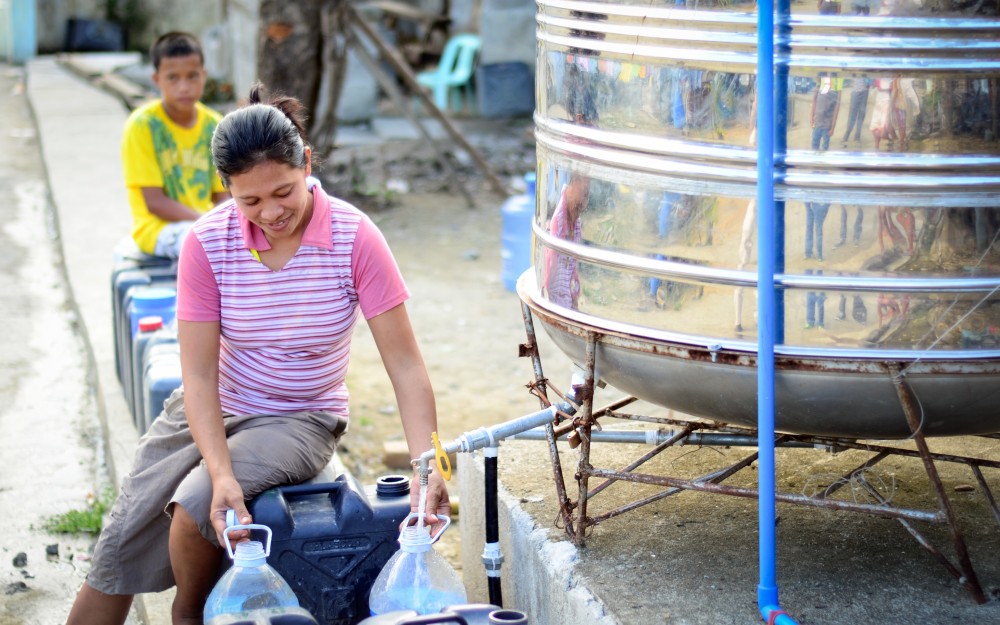
Last Thursday at the third session of our Development by Design: Dialogues in Architecture, Equity and Design, Susanna Oliver, project manager and head of the Catalunya office of World Vision, talked about the challenges of providing water access to some of the poorest, disaster-prone regions in the world.
Founded in 1950 by Robert Pierce, World Vision has grown to be one of the largest relief and development organizations in the world, working in nearly 100 countries, including the recently devastated island nation of Vanuatu. Susanna has extensive experience managing aid projects in developing countries with the organization, which collaborated with Roca’s We Are Water Foundation in providing safe access to water for over 500 families in the Philippines after Typhoon Haiyan.
In this dialogue, our faculty member Emilio Hormias talked to Susanna about how she started working in development and about how the organization carries out its mission of bring safe water access to post-disaster scenarios, most specifically in the case of the Philippines. Here’s a recap.

Challenges: Culture, geography, land tenure, inflation
“Sometimes the most difficult decision to make is choosing which communities to help.” In the Philippines, for example, while most organizations were working in Tacloban, World Vision decided they would be more useful in lesser known communities that were receiving less attention and needed the most assistance.
“Once this has been decided, you inevitably run into other obstacles.” Susanna brought up their work with latrines as an example of cultural barriers. When latrines are rejected by locals due to their unfamiliarity, World Vision, like many other organizations, develop a strategy that uses the influence of community leaders to change local opinion and habits over time.
Land tenure is also a common problem in developing countries, where tenants are often not owners of the land they live on, complicating the reconstruction process and requiring prolonged and multilateral negotiations. The inflation of goods due to the surge in demand for building materials, etc., is yet another burden on rebuilding efforts.
Other obstacles are specific to place. In the Philippines, the difficulty lay not in accessing water which could be found just 10 meters underground, but in the number of islands to reach: about 7000 of them.

Providing water to empower communities
World Vision is the largest NGO to work with water-related projects, employing 4000 workers and providing water and sanitation to one million people every year for the last three years and to a total of 16 million people in the last 28 years. “In an emergency, we provide the safest water, even if it is more expensive to import bottled water. In our development work, we dig wells and set up water treatments.” Providing water, however, is only a means to an end. Safe water after an emergency allows a community to recover, while building wells, installing pumps and establishing protocols and training programs to maintain water quality is essential to the communities’ long-term development.

Coordination and local knowledge
As an economist, Susanna had thought development was a field for professors, doctors and such, until she realized that her knowledge and strategical capacities were incredibly useful during her first three years working for World Vision in Honduras after Hurricane Mitch back in 1998.
“Our main strategy is coordination,” Susanna emphasized, with local and national governments, as well as advocacy to communicate rights to the local population so that they are able to influence the decisions that affect them.
When Typhoon Haiyan destroyed 36,289km of the Philippines’ coastline in 2013 and invaded 70-80% of it with seawater, World Vision already had a team of international specialists in place that responds to emergencies in Asia and the Pacific Region. “In 48 hours they were already there. They knew the context and work with local people that can help them.”
Susanna highlighted the importance of working not only with the affected communities, but with local professionals. “Most of us [at World Vision] work in our home country, because it is so important to know the context, the government and how society works.”

Measuring impact
World Vision devotes about 3 months to emergency phases, up to a year for reconstruction, and a total of 15 years for long-term community development programs. In order to evaluate their work, the organization carries out both quantitative and qualitative evaluations every five years which involves asking the communities for feedback. Through these evaluations, it has been able observe, for example, that in several cases the number of girls going to school doubles with improvements in water and sanitation.
“When water is not readily available, it is the girls in the community who go and fetch the water, so water is very much a matter of gender,” Susanna said, illustrating her earlier point of empowerment through water access. In an external audit in 2011, 90% of the wells built by the organization were still working after 10 years, which at the least, is a testament to effective maintenance training.
So what happens after 15 years? After a two-year transition, the locals are in charge. “In our projects, it is the leaders of the community who decide what they need. It’s a long term process.”
Stay tuned to the announcment of our fourth and final session next April 21st featuring architect Teddy Cruz! Stay tuned for updates here and on Facebook and Twitter.
More photos from the event:









All photos unless otherwised specified © Roca Barcelona Gallery

